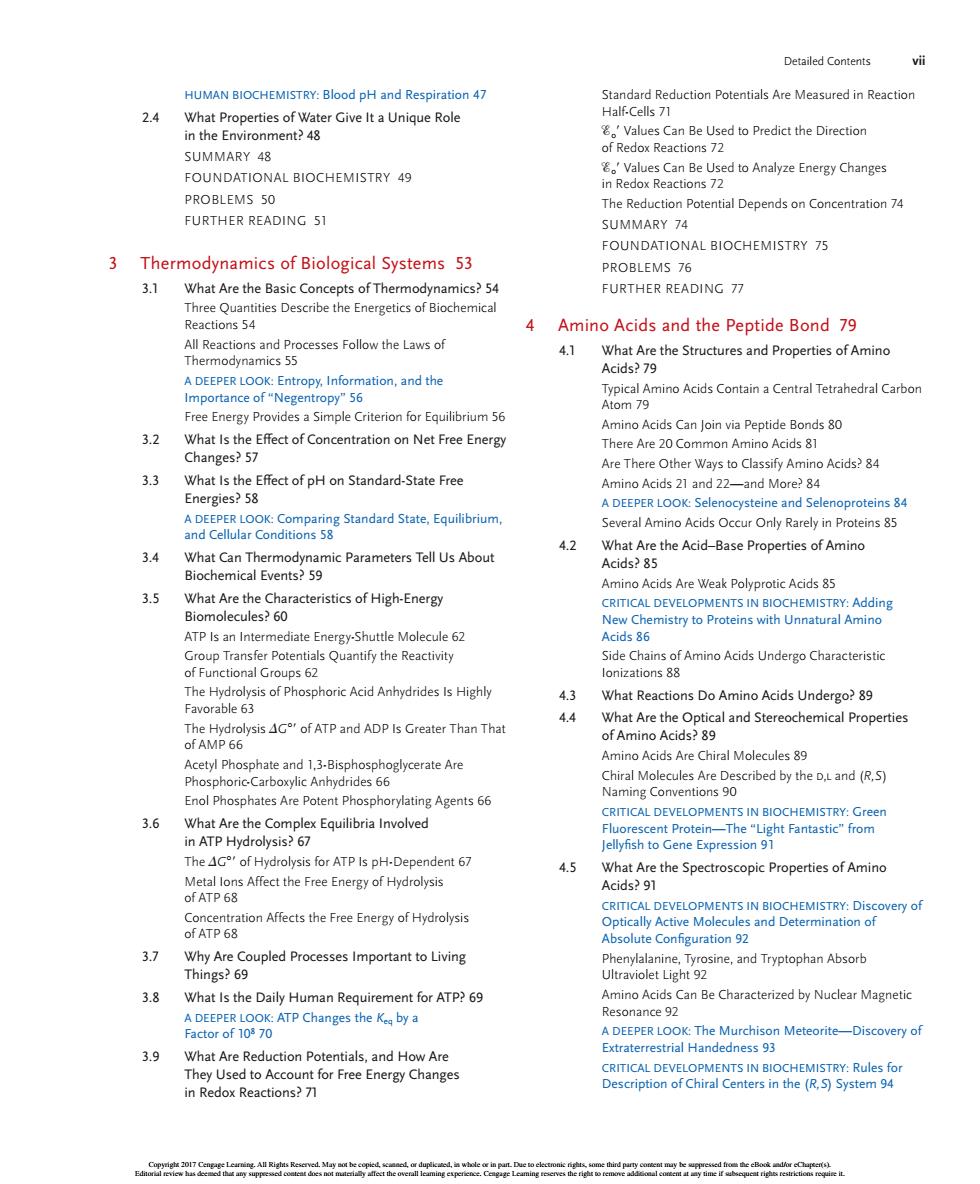正在加载图片...

Detailed Contents HUMAN BIOCHEMISTRY:Blood ph and respiration 47 Standard Reduction Potentials Are Measured in Reaction 2.4 Half.Cells71 Vaes Can Be Used o Predict the Direction SUMMARY 48 FOUNDATIONAL BIOCHEMISTRY 49 in Redox Reactions 7 to Analyze Energy Changes PROBLEMS 50 The Reduction Potential Depends on Concentration 74 FURTHER READING 51 SUMMARY 74 FOUNDATIONAL BIOCHEMISTRY 75 3 Thermodynamics of Biological Systems 53 3.1 FURTHER READING 77 Reactions 54 4 Amino Acids and the Peptide Bond 79 the Structures and Properties of Amino ation,and the mino Acids Contain a Central Tetrahedral Carbor FoEeepodeas9peCteionforEaulbrium56 Atom 79 Amino Acids Can Join via Peptide Bonds 80 3.2 There Are 20 Common Amino Acids 81 Are There Other Ways to Classify Amino Acids?84 33 cfHond-Fr Amino Acids 21 and 22-and More?84 A DEEPER LOOK:Selenocysteine and Selenoproteins 84 Several Amino Acids Occur Only Rarely in Proteins 85 4.2 What Are the Acid-Base Properties of Amino 3.4 What Can Thermodynamic Parameters tell us about Acids?85 Biochemical Events?59 5 What Are the Characteristics of High-Energy Amino Acids Are Weak Polyprotic Acids 85 Biomolecules?60 ATP Is an Intermediate Energy-Shuttle Molecule 62 Acids 86 esno人u ric Acid Anhydrides Is Highly 4.3 What Reactions Do Amino Acids Undergo?89 4.4 What Are the Optical and Stereochemical Properties The Hydrolysis AG'of ATP and ADP Is Greater Than That of AMP66 of Amino Acids?89 Amino Acids Are Chiral Molecules 89 Acetyl Phosphate and 1.3.Bisphosp Chiral Molecules Are Described by the Dand (R.S) orylating Agents66 onventions 9 3.6 scentProtein TheLight Fantasi of H Jellyfish to Gene Expression9 olysis for ATP Is pH-De endent 67 4.5 What Are the Spectroscopic Properties of Amino of ATP 68 Acids?91 CTPegoaAcstheFetnegyofhdos overy of Absolute Configuration 92 Why Are Coupled Processes Important to Living Things?6 a 3.8 What Is the Daily Human Requirement for ATP?69 amino Aci Can Be Characterized by Nuclear Magnetic ADEEPER LOOK The Murchison Meteorite-Discovery of 39 Extraterrestrial Handedness 93 What Are Reduction Potentials,and How Are or Free Energy Change Detailed Contents vii Standard Reduction Potentials Are Measured in Reaction Half-Cells 71 %o9 Values Can Be Used to Predict the Direction of Redox Reactions 72 %o9 Values Can Be Used to Analyze Energy Changes in Redox Reactions 72 The Reduction Potential Depends on Concentration 74 SUMMARY 74 Foundational Biochemistry 75 PROBLEMS 76 Further Reading 77 4 Amino Acids and the Peptide Bond 79 4.1 What Are the Structures and Properties of Amino Acids? 79 Typical Amino Acids Contain a Central Tetrahedral Carbon Atom 79 Amino Acids Can Join via Peptide Bonds 80 There Are 20 Common Amino Acids 81 Are There Other Ways to Classify Amino Acids? 84 Amino Acids 21 and 22—and More? 84 A Deeper Look: Selenocysteine and Selenoproteins 84 Several Amino Acids Occur Only Rarely in Proteins 85 4.2 What Are the Acid–Base Properties of Amino Acids? 85 Amino Acids Are Weak Polyprotic Acids 85 Critical Developments in Biochemistry: Adding New Chemistry to Proteins with Unnatural Amino Acids 86 Side Chains of Amino Acids Undergo Characteristic Ionizations 88 4.3 What Reactions Do Amino Acids Undergo? 89 4.4 What Are the Optical and Stereochemical Properties of Amino Acids? 89 Amino Acids Are Chiral Molecules 89 Chiral Molecules Are Described by the d,l and (R,S) Naming Conventions 90 Critical Developments in Biochemistry: Green Fluorescent Protein—The “Light Fantastic” from Jellyfish to Gene Expression 91 4.5 What Are the Spectroscopic Properties of Amino Acids? 91 Critical Developments in Biochemistry: Discovery of Optically Active Molecules and Determination of Absolute Configuration 92 Phenylalanine, Tyrosine, and Tryptophan Absorb Ultraviolet Light 92 Amino Acids Can Be Characterized by Nuclear Magnetic Resonance 92 A Deeper Look: The Murchison Meteorite—Discovery of Extraterrestrial Handedness 93 Critical Developments in Biochemistry: Rules for Description of Chiral Centers in the (R,S) System 94 Human Biochemistry: Blood pH and Respiration 47 2.4 What Properties of Water Give It a Unique Role in the Environment? 48 SUMMARY 48 Foundational Biochemistry 49 PROBLEMS 50 Further Reading 51 3 Thermodynamics of Biological Systems 53 3.1 What Are the Basic Concepts of Thermodynamics? 54 Three Quantities Describe the Energetics of Biochemical Reactions 54 All Reactions and Processes Follow the Laws of Thermodynamics 55 A Deeper Look: Entropy, Information, and the Importance of “Negentropy” 56 Free Energy Provides a Simple Criterion for Equilibrium 56 3.2 What Is the Effect of Concentration on Net Free Energy Changes? 57 3.3 What Is the Effect of pH on Standard-State Free Energies? 58 A Deeper Look: Comparing Standard State, Equilibrium, and Cellular Conditions 58 3.4 What Can Thermodynamic Parameters Tell Us About Biochemical Events? 59 3.5 What Are the Characteristics of High-Energy Biomolecules? 60 ATP Is an Intermediate Energy-Shuttle Molecule 62 Group Transfer Potentials Quantify the Reactivity of Functional Groups 62 The Hydrolysis of Phosphoric Acid Anhydrides Is Highly Favorable 63 The Hydrolysis DG89 of ATP and ADP Is Greater Than That of AMP 66 Acetyl Phosphate and 1,3-Bisphosphoglycerate Are Phosphoric-Carboxylic Anhydrides 66 Enol Phosphates Are Potent Phosphorylating Agents 66 3.6 What Are the Complex Equilibria Involved in ATP Hydrolysis? 67 The DG89 of Hydrolysis for ATP Is pH-Dependent 67 Metal Ions Affect the Free Energy of Hydrolysis of ATP 68 Concentration Affects the Free Energy of Hydrolysis of ATP 68 3.7 Why Are Coupled Processes Important to Living Things? 69 3.8 What Is the Daily Human Requirement for ATP? 69 A Deeper Look: ATP Changes the Keq by a Factor of 108 70 3.9 What Are Reduction Potentials, and How Are They Used to Account for Free Energy Changes in Redox Reactions? 71 Copyright 2017 Cengage Learning. All Rights Reserved. May not be copied, scanned, or duplicated, in whole or in part. Due to electronic rights, some third party content may be suppressed from the eBook and/or eChapter(s). Editorial review has deemed that any suppressed content does not materially affect the overall learning experience. Cengage Learning reserves the right to remove additional content at any time if subsequent rights restrictions require it